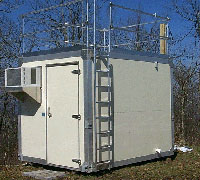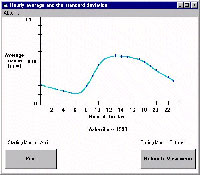Index
- What is the Ozone Calculator
- Why Use the Ozone Calculator
- How Do You Download Hourly Ozone Data
- Software Specifications and Installation
- Disclaimer
What is the Ozone Calculator?
 The Ozone Calculator was developed to assist other USDA Forest Service personnel in how to summarize hourly average ground-level ozone data. The Ozone Calculator is designed to analyze one or more months of continuous ozone monitoring data taken in a calendar year. The software assists a person in:
The Ozone Calculator was developed to assist other USDA Forest Service personnel in how to summarize hourly average ground-level ozone data. The Ozone Calculator is designed to analyze one or more months of continuous ozone monitoring data taken in a calendar year. The software assists a person in:
- Analyzing data in a biologically relevant manner. The user determines which months of the year will be used in the analysis.
- Providing a histogram showing the frequency of occurrences of ambient ozone in 0.010 parts per million (ppm) categories.
- Providing an average ozone exposure for each hour of the day. This analysis is useful to determine if the data are showing a varying or flat diurnal pattern.
Why Use the Ozone Calculator?
 Assessing the potential impacts of ground-level ozone to forest vegetation is difficult since there is little research information that relates ambient ozone exposures to potential damage to forest vegetation. The approached used in this software is likely to overestimate any biomass reduction that will occur. The user of this software will be able to estimate a biomass reduction by using the W126 and the number of hours greater than or equal to 0.100 ppm (also called peaks or N100). These two values serve as inputs into equations that estimate the percent reduction in biomass. The studies used in the analysis were forest seedlings (young plants) exposed to varying amounts of ozone in open-top chamber studies. The user of the software is cautioned that the plants used in the experiments were well watered and fertilized during the course of the study. Plants growing under these favorable conditions are more likely to have an adequate uptake of ozone that will cause damage to the vegetation. There are numerous years vegetation in the forest environment may have less than optimum moisture and nutrients, and consequently the actual uptake of ozone by mature plants into the leaf may be less than those found in the open-top chambers used in the experiments.
Assessing the potential impacts of ground-level ozone to forest vegetation is difficult since there is little research information that relates ambient ozone exposures to potential damage to forest vegetation. The approached used in this software is likely to overestimate any biomass reduction that will occur. The user of this software will be able to estimate a biomass reduction by using the W126 and the number of hours greater than or equal to 0.100 ppm (also called peaks or N100). These two values serve as inputs into equations that estimate the percent reduction in biomass. The studies used in the analysis were forest seedlings (young plants) exposed to varying amounts of ozone in open-top chamber studies. The user of the software is cautioned that the plants used in the experiments were well watered and fertilized during the course of the study. Plants growing under these favorable conditions are more likely to have an adequate uptake of ozone that will cause damage to the vegetation. There are numerous years vegetation in the forest environment may have less than optimum moisture and nutrients, and consequently the actual uptake of ozone by mature plants into the leaf may be less than those found in the open-top chambers used in the experiments.
The Ozone Calculator also provides two other analysis tools. First, the maximum 8-hour average ozone value is calculated for each day when there are an adequate number of hourly average ozone values. This routine will be useful to the user in determining if the National Ambient Air Quality Standard (0.070 ppm) is being exceeded at the monitoring site. The last analysis tools allow the user to display each valid hourly average ozone value for any day within the year.
The software has useful information to help the user operate the program and interpret the results. Tool tips have been used to ease the use of operating the software. The tips are found by placing the cursor over an item for a couple of seconds. Many of the buttons and text boxes have a message that will be displayed to help the user in operating the software. Finally, there is information found under the "About" tabs that will help inform the user on ground-level ozone in the forest environment, as well as assistance in how to interpret the results.
How Do You Download Hourly Ozone Data?
Ozone data has been obtained by the USDA Forest Service for numerous monitoring sites and can be downloaded for use with the Ozone Calculator. The files are organized in folders arranged by the Federal Information Processing Standard (FIPS) codes, which are a unique number for each state and county combination in the United States. Once you are in the correct folder then there will be an ASCII file (.txt) for each year of data. The file name is composed of the Site_ID plus an underline (_) and the year the data was collected. Once you locate the file(s) of interest then right click on the file name and select "Select Target As …" in your web browser window. Place the file in the c:\ozone_calc folder (or any folder of your choosing) then navigate to the folder with this data when you are using the Ozone Calculator.
You can also use an internet map locator to select a location and down load the data. The map shows (as dots) historical monitoring locations in the United States where data can be downloaded and used with the Ozone Calculator. Once the monitoring sites are shown on the webpage then navigate (using the zoom and other tools described in the "Instructions" on the bottom of the webpage) to the monitoring site you would like to download data. Next, use your mouse and click on the point (monitoring location) and a box of choices will appear. Next, select "Hourly Ozone Data for Ozone Calculator" to navigate to the internet folder that contains one or more years of ambient ozone monitoring data for the site you selected. You will likely have multiple years of data for a particular site and the file name is the Site_ID plus an underline (_) and the year the data was collected. All of the files are ASCII text (.txt) files. Once you locate the file(s) of interest then right click on the file name and select "Select Target As …" in your web browser window. Place the file in the c:\ozone_calc folder (or any folder of your choosing) then navigate to the folder with this data when you are using the Ozone Calculator.
Software Specifications and Installation
The Ozone Calculator runs on Windows 95 or higher. The user can download an executable zip file that will contain 3 files (ozone_calc.CAB, setup.exe, and Setup.lst). The executable zip file can be downloaded into any directory of your choosing. Once the executable zip file is downloaded then it can be opened and the file contents will be present. Next, execute the setup.exe file. This executable file will place the Ozone Calculator (ozone_calc.exe) and four input files (Bent Creek 1998.txt, Frying Pan 1998.txt, San Bernardino 1998.txt, and Yellowstone 1998.txt) in the ozone_calc directory (unless you choose a different directory name). One other file, St6unst.log, will also be installed and this file is used when you want to uninstall the software using the Windows uninstall routine.
Disclaimer
The Ozone Calculator computer program is being made available with the understanding that the U.S. Department of Agriculture cannot assure its accuracy, completeness, reliability, or suitability for any purpose other than reported. The recipient may not assert any proprietary rights thereto or represent it to anyone as other than a Government- produced computer program.
No technical support is provided for this software for people who are not working in an official capacity for the United States Government. The software is within the public domain and can be freely distributed. The user of the software assumes responsibility for the installation and uninstalling of the software on their personal computer.
The use of trade or firm names in this publication is for reader information only; it does not imply endorsement by the U.S. Department of Agriculture of any product or service.
updated: 03/14/2013